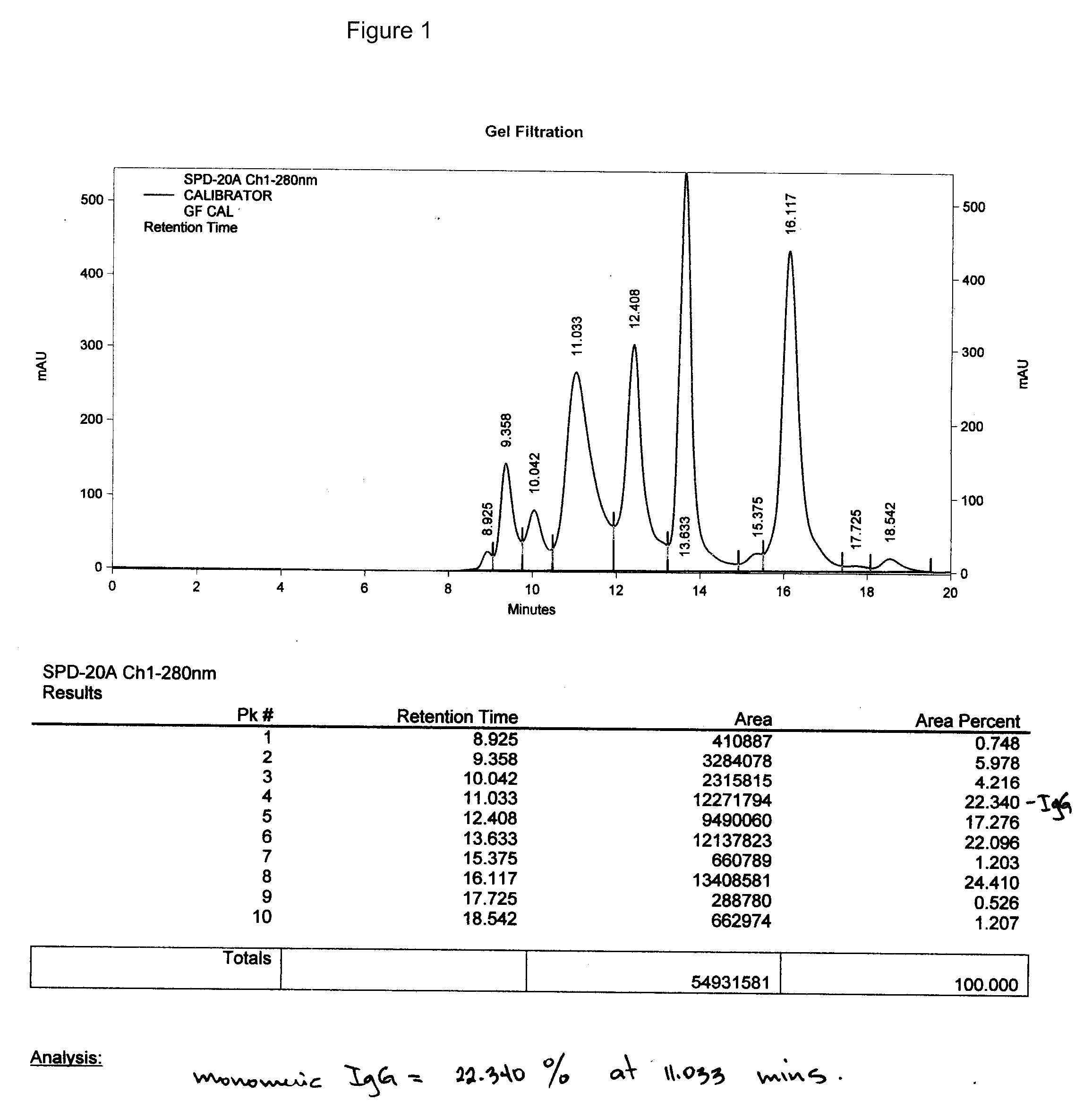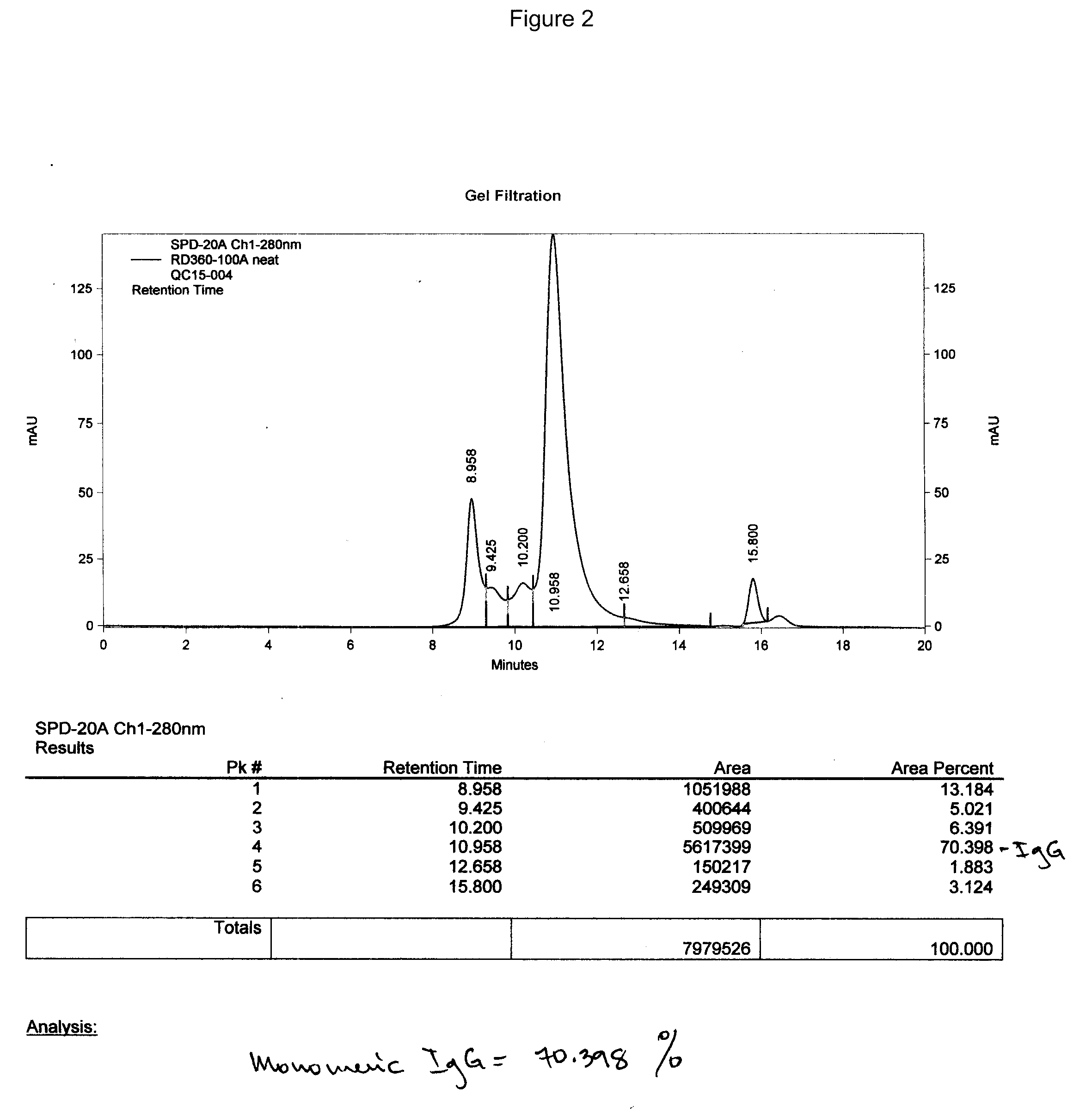Therapeutic and diagnostic affinity purified specific polyclonal antibodies
a technology of specific polyclonal antibodies and therapeutic and diagnostic applications, which is applied in the direction of antiparasitic agents, drug compositions, antibody medical ingredients, etc., can solve the problems of inability to effectively treat many types of infections, inability to achieve mab therapy, and limitations and drawbacks of ivig therapy
- Summary
- Abstract
- Description
- Claims
- Application Information
AI Technical Summary
Benefits of technology
Problems solved by technology
Method used
Image
Examples
example 1
Plasma Source
[0114]Approximately 100-1000 individuals are identified as being HCV positive using routine antibody-based diagnostics, e.g., ELISA or RIBA, for example HCV EIA 2.0 (Abbott Laboratories, Abbott Park, Ill.) or ORTHO HCV Version 3.0 ELISA (Ortho-Clinical Diagnostics, Inc. Raritan, N.J.). Approximately 750 mL of plasma is collected from each individual, to yield approximately 750 liters of total HCV-positive plasma. The plasma from the HCV-positive individuals is combined.
Affinity Column Preparation
[0115]One or more synthetic HCV peptides (See, e.g., Table 1) are synthesized using solid-phase synthesis (See, Atherton, E.; Sheppard, R. C. (1989). Solid Phase peptide synthesis: a practical approach. Oxford, England: IRL Press). The synthetic peptides contain epitopes located in diagnostically relevant antigenic regions derived from the E2 / NS4 / Core regions of HCV.
[0116]To prepare the affinity column, an amount of CNBr activated Sepharose 4B Sepharose gel (GE Healthcare Bio-Sc...
example 2
[0140]A subject is identified as being infected with Hepatitis C virus using routine diagnostic methods. The subject is administered a dose of the composition described in Example 1 by intravenous injection. Preferably, the dosage of anti-HCV antibody in the injection is in the range from about 100-200 mg of affinity purified human anti HCV.
[0141]The titer of HCV (or viral load) present in the subject's blood is determined before and after administration of the anti-HCV polyclonal antibody cocktail from Example 1. Depending on the viral load, the subject can be administered one or more additional doses. At the discretion of the medical care provider, the individual can receive additional administrations, e.g., the individual receives a single dose every 2 weeks for 60 weeks.
[0142]The following example describes the treatment of an individual with HIV using the compositions and methods disclosed herein.
example 3
[0143]A subject is identified as being infected with Human Immunodeficiency Virus (HIV) using routine diagnostic methods. The subject is administered a dose of a composition that includes a mixture of anti-HIV polyclonal antibodies that have been affinity purified from the plasma of several HIV positive individuals. The composition is parenterally administered. Preferably, the dosage of anti-HCV antibody in the composition is in the range from about 100-200 mg.
[0144]The titer of HIV (or viral load) present in the subject's blood is determined before and after administration of the anti-HIV polyclonal antibody cocktail. Depending on the viral load, the subject can be administered one or more additional doses.
[0145]The following example describes the treatment of an individual with L. monocytogenes using the compositions and methods disclosed herein.
PUM
| Property | Measurement | Unit |
|---|---|---|
| time | aaaaa | aaaaa |
| time | aaaaa | aaaaa |
| pH | aaaaa | aaaaa |
Abstract
Description
Claims
Application Information
 Login to View More
Login to View More - R&D
- Intellectual Property
- Life Sciences
- Materials
- Tech Scout
- Unparalleled Data Quality
- Higher Quality Content
- 60% Fewer Hallucinations
Browse by: Latest US Patents, China's latest patents, Technical Efficacy Thesaurus, Application Domain, Technology Topic, Popular Technical Reports.
© 2025 PatSnap. All rights reserved.Legal|Privacy policy|Modern Slavery Act Transparency Statement|Sitemap|About US| Contact US: help@patsnap.com


